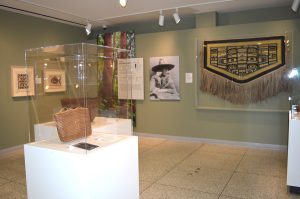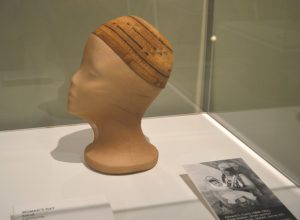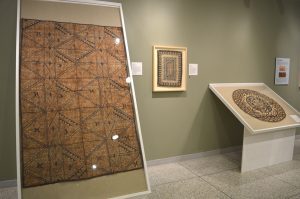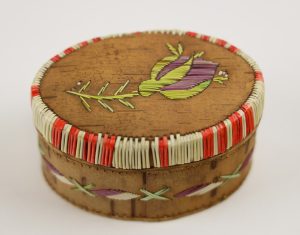 The use of tree bark is global and ubiquitous. Indigenous communities have been harvesting and using bark for thousands of years. Fort Rock Cave in the Pacific Northwest contains numerous well-preserved sandals made from sagebrush bark, dating from 9,000 to 13,000 years old. Globally, communities continue to use bark to create everyday objects, works of art and as a source of food and medicine. In the new exhibition, “Bark! Indigenous Cultural Expressions,” on display at the NJ State Museum through January 5, 2025, visitors will see examples from South America, the Pacific Islands, the Pacific Northwest and the Eastern Woodlands.
The use of tree bark is global and ubiquitous. Indigenous communities have been harvesting and using bark for thousands of years. Fort Rock Cave in the Pacific Northwest contains numerous well-preserved sandals made from sagebrush bark, dating from 9,000 to 13,000 years old. Globally, communities continue to use bark to create everyday objects, works of art and as a source of food and medicine. In the new exhibition, “Bark! Indigenous Cultural Expressions,” on display at the NJ State Museum through January 5, 2025, visitors will see examples from South America, the Pacific Islands, the Pacific Northwest and the Eastern Woodlands.
Assistant Curator Karen Flinn has spent over 45 years working with the Museum’s ethnographic collection and often uses the collection to explore a specific theme across several continents. The Bark exhibition is the latest example of this unique perspective. Comparing centuries-old bark made objects with the work of modern indigenous artists we can see how these objects sustain and connect communities all over the world.
Similar to skin, bark is the outer covering of a tree. It adapts to protect the living tree from the environment and protects delicate tissues from diseases and insect attack. Bark is traditionally stripped in spring and can be sustainably harvested without damaging the tree. Historic evidence of bark stripping remains all over North America, we can even date when the bark was stripped! Archaeologists count the growth rings adjacent to the scar to tally the years passing since the scar was made.
 In the Pacific Northwest, cedar bark is excellent for weaving. Baskets, capes, and hats are some of the items woven from cedar bark. Indigenous people continue to pass on these skills to make and use similar items today. The exhibition features a woman’s cap from the Karuk tribe of Northern California that dates to the 1850s. The Karuk and Hupa lands border each other and the people share similar cultural identities. Women of both tribes still make and wear hats like these today.
In the Pacific Northwest, cedar bark is excellent for weaving. Baskets, capes, and hats are some of the items woven from cedar bark. Indigenous people continue to pass on these skills to make and use similar items today. The exhibition features a woman’s cap from the Karuk tribe of Northern California that dates to the 1850s. The Karuk and Hupa lands border each other and the people share similar cultural identities. Women of both tribes still make and wear hats like these today.
 Bark cloth, or tapa, is not a woven material, but made from bark that has been softened through a process of soaking and beating. The inner bark is harvested from several types of trees or shrubs, often mulberry and fig, and designs applied with paints and vegetable dyes of light brown, red, and black. Indigenous Peoples in South America, Africa, Japan and Southeast Asia were all pioneers in the creation of bark clothing. Despite the different tree species and cultures involved, a similar method for making bark cloth has evolved on all three continents, causing those regions to sometimes be known as “the bark belt.” Tapa cloths also continue to be made today.
Bark cloth, or tapa, is not a woven material, but made from bark that has been softened through a process of soaking and beating. The inner bark is harvested from several types of trees or shrubs, often mulberry and fig, and designs applied with paints and vegetable dyes of light brown, red, and black. Indigenous Peoples in South America, Africa, Japan and Southeast Asia were all pioneers in the creation of bark clothing. Despite the different tree species and cultures involved, a similar method for making bark cloth has evolved on all three continents, causing those regions to sometimes be known as “the bark belt.” Tapa cloths also continue to be made today.
Birch bark is a strong and water-resistant cardboard-like bark that can be easily cut, bent, and sewn. This versatility has made it a valuable structural, crafting, and writing material since pre-historic times. In the Eastern Woodlands, tribes of Lenape, Passamaquoddy, Ojibwe, Mi’kmaq and others use birch in a variety of ways. Birch canoes have been in use for over 3,000 years. They took many hours of manual labor to complete, and they proved to be incredibly durable. On display is a birch bark canoe model from Maine, used to teach and preserve canoe-making skills within the Passamaquoddy communities in the 1980’s.
Also on display is a Delaware Indian House model made by NJ State Museum Indian Site Survey Staff through a project funded by the Works Project Administration (1935-43). Lenape/Delaware bark-covered homes have traditionally used chestnut, oak, linden (basswood), poplar and elm bark. Bark cordage was also used to tie the frame together. This model was loaned to teachers in New Jersey Public schools to teach their students about Delaware Indian housing.
 There are a number of birch bark boxes in the Museum’s collection. Boxes on exhibit were made to sell to tourists in the Bar Harbor Maine area in the early 20th century. At this time Indigenous communities were restricted from land use and adapted to create trade items to obtain necessary goods. The colorful quillwork on these boxes is typical of the Eastern Woodlands region. Before the introduction of glass trade beads by Europeans in the 18th century, quillwork was widely used for decorative elements on clothing, shoes, and all kinds of containers. Eastern Woodlands tribes continue to make birch bark boxes, passing on the tradition of working with birch bark and quillwork to preserve skills for the benefit of their communities.
There are a number of birch bark boxes in the Museum’s collection. Boxes on exhibit were made to sell to tourists in the Bar Harbor Maine area in the early 20th century. At this time Indigenous communities were restricted from land use and adapted to create trade items to obtain necessary goods. The colorful quillwork on these boxes is typical of the Eastern Woodlands region. Before the introduction of glass trade beads by Europeans in the 18th century, quillwork was widely used for decorative elements on clothing, shoes, and all kinds of containers. Eastern Woodlands tribes continue to make birch bark boxes, passing on the tradition of working with birch bark and quillwork to preserve skills for the benefit of their communities.
Bark can tell many stories. In researching and preparing for this new exhibition, we have discovered more than could possibly be told. Throughout the run of the exhibition, we will be offering visitors opportunities to explore more through story times, gallery carts and crafting opportunities. We encourage you to visit the Museum to see this exhibition and experience these stories and objects for yourself. Check our website for more information and an upcoming events calendar. www.statemuseum.nj.gov
 Beth Cooper has been the Curator of Education at the New Jersey State Museum since April 2012. In this role, Beth has focused on expanding programming, partnerships and community engagement. Prior to joining the Museum, Beth was the Director of Education at the National Museum of Dentistry, a Smithsonian Affiliate, on the campus of the University of Maryland, Baltimore. Beth started her career in Nashville, TN and was on the board of the Inter-Museum Council of Nashville and the Tennessee Association of Museums. She earned her M.S. Ed. Leadership in Museum Education, Bank Street College of Education, 2006 and B.S. Historic Preservation/Ethnography/Public History, Southeast Missouri State University, 1996.
Beth Cooper has been the Curator of Education at the New Jersey State Museum since April 2012. In this role, Beth has focused on expanding programming, partnerships and community engagement. Prior to joining the Museum, Beth was the Director of Education at the National Museum of Dentistry, a Smithsonian Affiliate, on the campus of the University of Maryland, Baltimore. Beth started her career in Nashville, TN and was on the board of the Inter-Museum Council of Nashville and the Tennessee Association of Museums. She earned her M.S. Ed. Leadership in Museum Education, Bank Street College of Education, 2006 and B.S. Historic Preservation/Ethnography/Public History, Southeast Missouri State University, 1996.
 Karen Flinn is the Assistant Curator of Archaeology & Ethnography at the New Jersey State Museum. She has over 36 years of experience working with archaeological and ethnographic collections as well as experience in all aspects of museum management including collections care and exhibition planning and implementation. Her research interests include Native American cultural adaptation over time, the cultural diversity and change within New Jersey’s various cultural groups and the study of the contact between New Jersey’s Native Americans and European colonists.
Karen Flinn is the Assistant Curator of Archaeology & Ethnography at the New Jersey State Museum. She has over 36 years of experience working with archaeological and ethnographic collections as well as experience in all aspects of museum management including collections care and exhibition planning and implementation. Her research interests include Native American cultural adaptation over time, the cultural diversity and change within New Jersey’s various cultural groups and the study of the contact between New Jersey’s Native Americans and European colonists.
